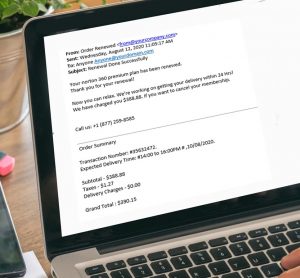Rise of the Phishing/Vishing Scam
We all have received that email stating that a charge has been made to our account: Microsoft, GoDaddy, Adobe, FedEx, etc. All we need to do is click on the link and enter our username and password to view, confirm, or dispute the charge. This is a common phishing email scam. The link redirects you to a web page that looks just the web page of the service stated. Sometimes people enter in their username and password and nothing happens. They try again with different passwords. Not realizing that every time they enter in data it is being recorded in which people with malice intents sell that info or use it to gain access to your account to get info or forward messages. This is something that has been common-place for a while now and we have seen an increase in this with COVID-19 forcing many to work from home. However, we are seeing a new trend emerge.
Vishing works very similarly to Phishing, but it is done over the phone. The twist that we are seeing here is that an email is sent without a weblink but instead a phone number asking the recipient to call if there is an error. Let’s look at the example below:

This is an actual email that was sent. They only thing that I had changed on it was the recipient name and email address. Everything else is as it was. The first red flag is the email address that this came from. from@yourcompany.com This tells me two things, It is not real and the program they are using to send out these fake emails was not configured correctly. The second red flag is that the n in Norton is not capitalized. The third red flag is that there is no account number or last four of a credit card number. The fourth red flag is the spacing and the use of characters that don’t fit into where they are. The fifth red flag is the delivery date of 10/8/2020 when the first section says delivery in 24 hours. The sixth red flag is the tax on the total of $388.88.
With all of that aside; I can see how someone may be confused and concerned. They don’t want to be charged so they call then the number. I called the number to see how they are trying to scam people. Basically what they do is ask for the transaction number; which I am almost sure is just a random number. Then for “Security”, they ask you to confirm your name, company, email address. They will then say “Thank you for that info. What can we help you with today.” The caller will then explain the issue and the charge and ask for it to be removed. This is how they get your credit card number. They will ask you to provide the credit card number to remove the charge. For security reasons they cannot give you the number, they have on file. You have to provide it to them. This is the scam and how they get you. Don’t fall for the scam.
If you have any questions about this or other cybersecurity issues with your business feel free to contact me.
Michael Douglas
Service Delivery Manager
Texas Data and VoIP Security
Sales & Support: (972) 924-5010 ex.1004
Office: 972-924-5871
Email: MDouglas@tdavinc.com
web: www.tdavinc.com





